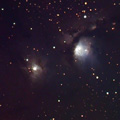CXC Home | Search | Help | Image Use Policy | Latest Images | Privacy | Accessibility | Glossary | Q&A

Optical & X-ray Views of McNeil's Nebula
QuickTime MPEG This sequence leads the viewer from a ground-based optical view around McNeil's Nebula through to Chandra's up-close X-ray image. It begins with the picture of the region that amateur astronomer Jay McNeil took with his 3-inch telescope, which led to the discovery of the nebula (and hence the name). The images then proceed to increasingly smaller optical views of the nebula and its immediate environment. The sequence ends by showing Chandra's observation of the source at the apex of McNeil's Nebula, which was seen to flare in X-rays. The X-ray data suggest the outburst was caused by an infall of material onto the star's surface from an orbiting disk of gas.
[Run Time: 0:25]
(Credit: Optical, wide-fields: Jay McNeil
Optical, close-up: NSF/NOAO/KPNO/A.Block et al.
X-ray: NASA/CXC/RIT/J.Kastner et al.)
QuickTime MPEG This sequence leads the viewer from a ground-based optical view around McNeil's Nebula through to Chandra's up-close X-ray image. It begins with the picture of the region that amateur astronomer Jay McNeil took with his 3-inch telescope, which led to the discovery of the nebula (and hence the name). The images then proceed to increasingly smaller optical views of the nebula and its immediate environment. The sequence ends by showing Chandra's observation of the source at the apex of McNeil's Nebula, which was seen to flare in X-rays. The X-ray data suggest the outburst was caused by an infall of material onto the star's surface from an orbiting disk of gas.
[Run Time: 0:25]
(Credit: Optical, wide-fields: Jay McNeil
Optical, close-up: NSF/NOAO/KPNO/A.Block et al.
X-ray: NASA/CXC/RIT/J.Kastner et al.)
Return to McNeil's Nebula (22 Jul 04)


